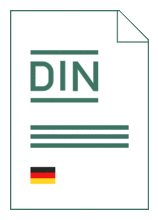
Standard [CURRENT]
DIN EN 13001-3-1:2025-07
Cranes - General design - Part 3-1: Limit states and proof competence of steel structure; German version EN 13001-3-1:2025
- German title
- Krane - Konstruktion allgemein - Teil 3-1: Grenzzustände und Sicherheitsnachweis von Stahltragwerken; Deutsche Fassung EN 13001-3-1:2025
- Publication date
- 2025-07
- Original language
- German
- Pages
- 148
- Publication date
- 2025-07
- Original language
- German
- Pages
- 148
- DOI
- https://dx.doi.org/10.31030/3485247
Product information on this site:
Quick delivery via download or delivery service
All transactions are encrypted
Overview
This standard includes safety requirements. This standard specifies requirements of the EU ATEX Directive 94/9/EC and thus relevant requirements of Annex I of the EU Machinery Directive 2006/42/EC for machines placed on the market for the first time in the European Economic Area (EEA) in order to facilitate the demonstration of conformity with these requirements. Once this standard is cited in the Official Journal of the European Union, it is deemed a "harmonized" standard and thus, a manufacturer applying this standard may assume compliance with the requirements of the Machinery Directive ("presumption of conformity"). This document specifies limit states, requirements and methods to prevent mechanical hazards in steel structures of cranes by design and theoretical proof of competence. The significant hazardous situations and hazardous events that could result in risks to persons during intended use are identified in Annex L. Clauses 4 to 8 of this document provide requirements and methods to reduce or eliminate these risks: a) exceeding the limits of strength (yield, ultimate, fatigue); b) exceeding temperature limits of material or components; c) elastic instability of the crane or its parts (buckling, bulging). This document is not applicable to cranes which are designed before the date of its publication as EN and serves as reference base for the European Standards for particular crane types (see Annex K). This document deals only with the limit state method in accordance with reference [44]. This document (EN 13001-3-1:2023) has been prepared by Technical Committee CEN/TC 147 "Cranes - Safety", the secretariat of which is held by DIN. The standard differs from DIN EN 13001-3-1:2019-03 as follows: - the design values for standardized steels (4.2.1) have been moved to a new Annex M (informative); - design values for bolt materials have been changed (Table 4); - limit design values for welded connection have been changed (5.2.5); - static proof of welded connections has been changed (5.3.4 and Annex C (normative)); - proof of fatigue strength has been revised to include additional modern methods (6.1); - fatigue strength specific resistance factors have been modified (Table 8); - the geometric stress (Hot Spot) method has been added (6.2.4 and Annex I (normative)); - the effective notch method has been added (6.2.5 and Annex I (normative)); - lateral torsional stability of beams has been added (8.4 and 8.5.3 and Annex J (informative)); -recommended tightening torques for preloaded bolts have been modified (Annex B (informative)); - characteristic fatigue strengths for plates in shear have bee modified (Table D.1); - Annex L (informative) with a list of hazards has been inserted; - Annex ZA (informative) has been significantly revised. This European Standard is one part of the EN 13001 series of standards. The other parts are: - Part 1: General principles and requirements; - Part 2: Load actions; - Part 3-2: Limit states and proof of competence of wire ropes in reeving systems; - Part 3-3: Limit states and proof of competence of wheel/rail contacts; - Part 3-4: Limit states and proof of competence of machinery; - Part 3-5: Limit states and proof of competence of forged hooks. - Part 3-6: Limit states and proof of competence of hydraulic cylinders. The national interests during the preparation were represented by Committee NA 060-22-10 AA "Lenkungsausschuss Krane und Hebezeuge" ("Steering committee cranes and lifting equipment") and mirror committee NA 060-22-10-22 AK "Konstruktion, Ausrüstungen (SpA CEN/TC 147/WG 3)" ("Design - requirements for equipment") (SpA CEN/TC 147/WG 3) at Technical Section "Krane und Hebezeuge" ("Cranes and lifting equipment") at DIN Standards Committee Mechanical Engineering (NAM). Representatives of the manufacturers and users of cranes and lifting equipment as well as of professional and trade associations were involved in the preparation.
Content
ICS
DOI
This document replaces DIN EN 13001-3-1:2019-03 .

